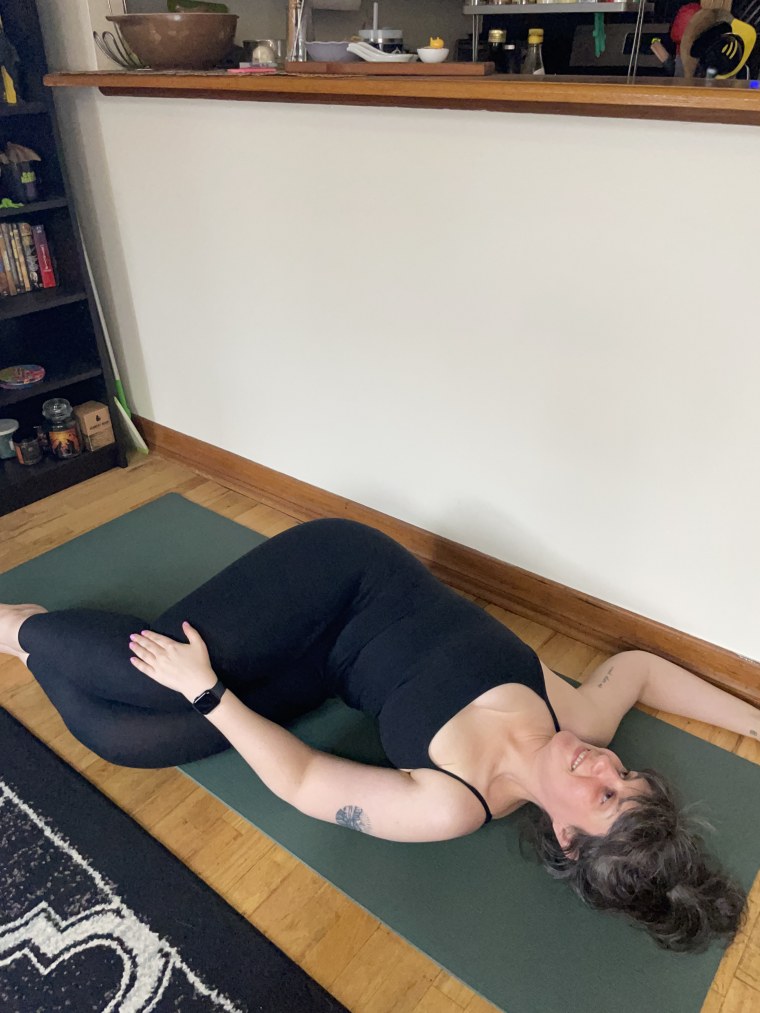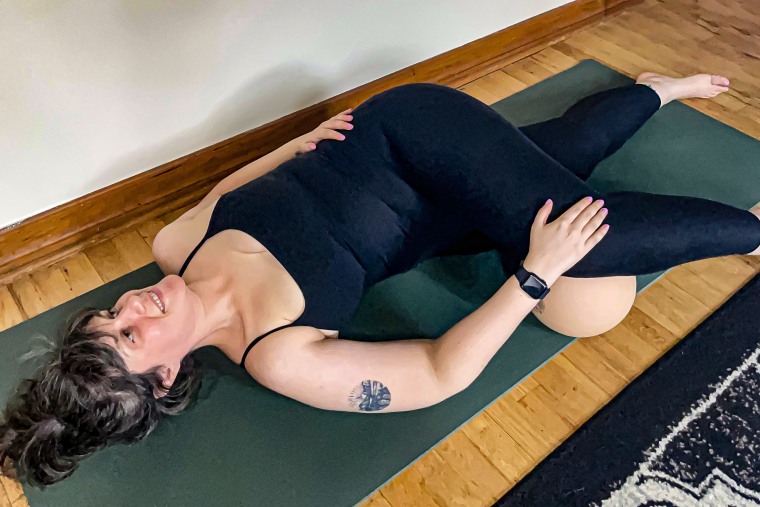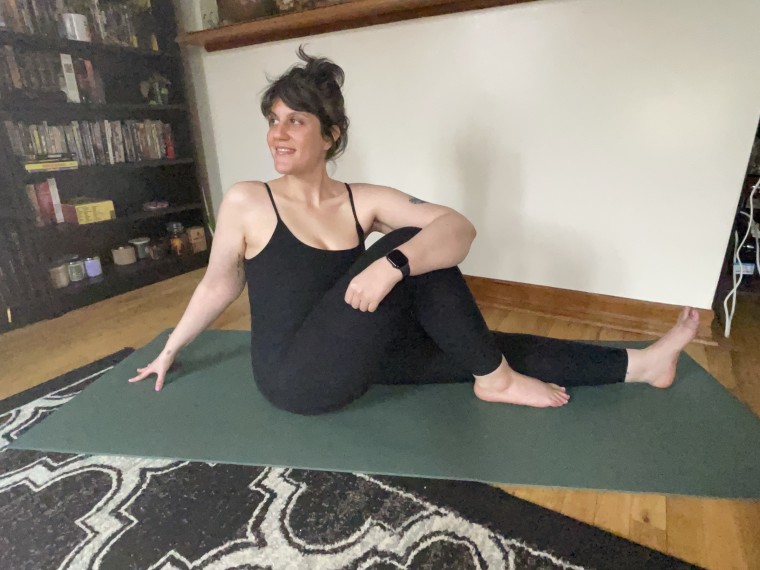Welcome to Start TODAY. Sign up for our Start TODAY newsletter to receive daily inspiration sent to your inbox — and join us on Instagram!
When you have back pain, doing a twist probably isn't the first type of stretch that comes to mind. But experts say it's actually important to learn how to rotate our spine properly to perform all kinds of daily movements. And, if done correctly, spinal twist stretches can have all sorts of benefits — including relief from back pain and muscle tension.
"There's this misbelief that twisting and rotating is not good, and we shouldn't be doing it," Paul Spano, a physical therapist in the NYU Langone Sports Medicine Department, tells TODAY.com. "Contrary to that, (twisting is) actually a very important aspect for proper and healthy spine mobility."
As a golfer, Spano needs to incorporate healthy rotation into his movement practices, he says. "And I try to incorporate it into many of the (plans) for the patients that I'm working with, especially those who have back-related injuries."
In fact, performing twising stretches has become a part of my own daily routine and I've noticed improvements in my back pain, sleep quality and stress levels.
That said, improper twisting — like rotating while bending down to pick something up too quickly — can lead to pain, he says.
And twisting isn't typically the first type of movement experts prescribe for patients with pain, Dr. Melissa Leber, an associate professor of orthopedics and emergency medicine at the Icahn School of Medicine at Mount Sinai, tells TODAY.com. "You don't usually start with that, even though it does have its benefits," she says.
Here's what to know about using spinal stretches to improve your mobility and the other potential benefits of incorporating these gentle movements into your routine.
Spinal twist stretch benefits
Twisting movements are essential for many activities we perform every single day — including something as simple as walking, Spano says. And practicing spinal twists can help with mobility, provide some back pain relief and offer an opportunity for relaxation and breathing practice at the end of a tough day.
However, these movements aren't right for everyone, the experts say. For instance, people who just had surgery may want to avoid these movements or check in with their doctor first, Spano says. And people with certain health conditions, such as facet arthropathy (a type of arthritis that affects spinal joints), may find that twists actually exacerbate their pain, Leber says.
So, if you're not sure if you should try a spinal twist, speak with your doctor, physical therapist or other medical professional first.
Increased spinal mobility
One major benefit of performing spinal twists is increased flexibility and spinal mobility.
People with back pain may also have “an associated hip or pelvic related condition,” Spano says. “By introducing proper spinal mobility, you could also be (improving) hip mobility and pelvic mobility."
Rotational exercises like this can also help people dissociate the movement of their trunk from that of their hips, Spano explains, which is often challenging. Without good control over those parts of the body, you may feel stiff and even walk in a "blocky" movement pattern, he says.
“If you can control the movements, that leads to healthier, better motions and, ultimately, preventing pain,” Spano explains.
People with reduced spinal flexibility might have trouble bending down to tie their shoes or lifting heavy items, Leber says, adding that a lack of flexibility puts people at risk for injury.
Pain relief
Stretching your back with a twist can reduce pain and improve mobility from your shoulders and thoracic spine all the way down to your lumbar spine, hips and glutes.
"We hold tension in our backs a lot, partly because we have a much more (technology-centered) world," Leber explains. "We're all sitting at our computers all day and we're not standing and moving as much."
Gentle twisting stretches can relieve muscle tension and "stretch common pain points in your low back," Leber says. "There's a lot of muscles that support your lower spine that are stretched by doing this exercise."
In particular, a supine twist can help relieve tension along the quadratus lumborum, also called the QL, Leber says. When people complain of lower back pain, this large, deep back muscle is often part of the problem. Certain twisting stretches can also get into the piriformis muscle, Spano adds, which can relieve tension in the glutes and hips as well.
Anyone with tight glutes and hips can also benefit from simple hamstring and calf muscle stretches, Leber adds.
As someone prone to lower back and hip aches due to nerve compression, twisting poses help keep me feeling more limber and pain-free — especially after workouts or days with lots of walking.
Relaxation
Twisting stretches, especially performed lying down, are a great opportunity to practice deep diaphragmatic breathing for further pain relief and relaxation, Spano says.
"Your ribs are attached to your mid-back and your thoracic spine, which attaches to your low back," he explains. "When you're twisting and performing some of this deep breathing, you're going to be mobilizing a lot of the tissues that are all interconnected throughout that whole system."
In general, "stretching is very relaxing and helps keep calm," Leber says.
Relaxing into these stretches with a few deep breaths gives me a moment of peace, which is why I especially love doing them before bedtime. With some calming breaths and less tension in my hips, I'm able to fall asleep more quickly.
Improved balance
If you progress to standing twists, you'll also be strengthening your muscles and challenging your balance. Standing variations can include simple standing twists with your arms outstretched, twisting lunges and the so-called “world’s greatest stretch.”
A twisting lunge, for instance, can be "a nice progression to challenge your back and all those postural muscles," Spano says. "It also challenges your balance because you're in a very narrowed stance when you're in that position."
Digestion
Some people find that twisting poses help manage bloating and constipation.
“The act of contracting and relaxing (abdominal and core muscles) and just motion itself helps your GI system mobilize everything that’s inside and, eventually, to be able to clear everything,” Spano says. “Spinal mobility and proper motion in general can absolutely help with any of those GI-related issues or complications,” he adds.
In fact, it’s not unusual for his clients who are recovering after major surgery to feel backed up due partly to a lack of movement. “One of the first things that happens once they start moving is they have to go to the bathroom,” Spano says. “And it’s because of that motion that’s helping all the muscles within the GI system.”
However, Leber does not recommend relying on spinal twists to alleviate gastrointestinal issues. “I would definitely not support that from a medical perspective,” she says.
How to perform a spinal twist
I do some variation of these stretches every day alongside other exercises I learned through physical therapy to help alleviate and prevent neck, shoulder, low back and hip pain. My stretching routine also helps me stay relaxed and grounded throughout the day and calm down before bed.

Simple spinal twist
Spano recommends beginners start with the version of the stretch involving both legs. In yoga, this pose is sometimes referred to as Jathara Parivartanasana.
To perform this stretch, as TODAY.com explained previously:
- Start on your back with your feet on the mat and your knees bent.
- From there, bring your knees in to your chest and then lower both knees toward the right, resting them on the floor. Your knees and legs should be stacked on top of each other.
- Stretch your arms wide and look toward your left hand, feeling a gentle stretch in the low back and hips, as well as the upper back and shoulders.
- Take a few deep breaths in this pose.
- When you're ready, bring your knees back to center and follow the same steps on the left side. This time, you'll open your arms and turn your head to the right.
If it feels too intense when your knees fall all the way to the floor, don't hesitate to use a prop — pillows, yoga blocks, folded blanket — to hold them up, Spano recommends. You can also put them between your legs or knees for more support.

Supine spinal twist
This is my preferred version of the pose because it’s just so relaxing with such little effort. It's such a treat to feel a great stretch while literally just lying down! You might also be familiar with this pose from yoga practice, where it’s sometimes referred to as Supta Matsyendrasana.
This pose is similar to the previous one, but you'll keep one leg straight while the other is bent.
- Start lying on your back with your legs outstretched.
- Keeping your right leg straight, bend your left leg at the knee and bring it to your chest.
- Let the left knee — still bent at about 90 degrees — fall over your right leg to twist. You can gently place your right hand on the left knee for a little more intensity.
- Let your left arm stretch out to the side while you look toward your left hand.
- Take a few deep breaths in this pose, then come back through center and repeat the stretch on the other side.
I feel this one more in my tight hips, piriformis and along my IT band. I also try to keep my shoulders on the ground to get a chest and upper back stretch too.
Sometimes I'll use a Pilates ball or yoga block to hold my bent knee up, which helps me stay in the pose a little longer without completely sinking. Other times I'll bend and straighten my top leg, moving it up and down to find what feels best that day.

Seated twist
If you prefer not to lie down, then a seated pose might suit you better.
To perform a seated spinal twist, as TODAY.com explained previously:
- Start in a seated position with your legs outstretched in front of you.
- Bend your right knee and cross your right leg over your left, resting your right foot flat on the ground near your left knee.
- Place your right hand on the floor behind you for support and hook your left arm around your right knee.
- Gently begin to twist your body toward the right from your core (not just your shoulders).
- Hold this for about 30 seconds, then repeat the stretch on the other side.
I find that a seated spinal twist is a nice way to wake up my shoulders, spine and lower back if I’ve been sitting at the computer for too long.